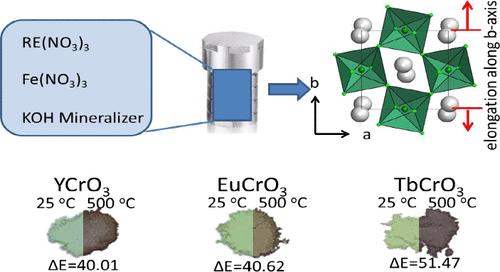RECrO3 as High-Contrast Thermochromic Memory Pigments: Enabled by Hydrothermal Distortions and Magnetic Tuning (RE = Eu, Tb, Y)
IF 4.7
2区 化学
Q1 CHEMISTRY, INORGANIC & NUCLEAR
引用次数: 0
Abstract
Inorganic crystals synthesized via different methods with the “same” composition often exhibit distinct properties, a phenomenon frequently overlooked or misinterpreted. In this work, we demonstrate the peculiar magnetic properties and thermochromic memory behavior of three perovskite-structure rare-earth chromites (RECrO3, RE = Eu, Tb, and Y) synthesized by a mineralizer-assisted hydrothermal method at 225 °C. The crystals feature an elongated b-axis and greater distortion of the CrO6 octahedral subunits. Crystal shapes are sensitive to the composition, mineralizer concentration, and reaction temperature. Raman and infrared peaks show a RE3+-dependent behavior. All samples are canted-antiferromagnetic with significantly lower Néel temperatures than the samples synthesized via other methods. Three notable magnetic transition points are shown in TbCrO3, which have never been found in other samples. Temperature and magnetic field dependent magnetization curves of EuCrO3 samples show crystal shape dependent magnetic behaviors. All of the samples show continuously irreversible thermochromic properties from 100 to 500 °C with color changes from yellowish green to reddish brown with the highest chromaticity aberration of ΔE = 51.47 in TbCrO3. This work indicates that the materials synthesized via the mineralizer-assisted hydrothermal crystallization method facilitate versatile tunability of the structure and physical properties with promising thermal recording applications.

高对比度热致变色记忆颜料RECrO3:水热变形和磁调谐(RE = Eu, Tb, Y)
通过不同方法合成的无机晶体具有“相同”的成分,通常表现出不同的性质,这一现象经常被忽视或误解。在这项工作中,我们证明了三种钙钛矿结构的稀土铬铁矿(RECrO3, RE = Eu, Tb和Y)在225℃下用矿化剂辅助水热法合成的特殊磁性和热致变色记忆行为。晶体具有拉长的b轴和更大的扭曲的八面体CrO6亚基。晶体形状对组成、矿化剂浓度和反应温度敏感。拉曼峰和红外峰表现出依赖于RE3+的行为。所有的样品都是斜反铁磁性的,与其他方法合成的样品相比,nsamel温度明显降低。在TbCrO3中发现了三个显著的磁过渡点,这在其他样品中从未发现过。温度和磁场对EuCrO3磁化曲线的影响表现为晶体形状对磁化行为的影响。所有样品在100 ~ 500℃范围内均表现出连续不可逆的热致变色性质,颜色从黄绿色到红棕色变化,TbCrO3的色差最高为ΔE = 51.47。这项工作表明,通过矿化剂辅助水热结晶方法合成的材料有助于结构和物理性质的通用可调性,具有很好的热记录应用前景。
本文章由计算机程序翻译,如有差异,请以英文原文为准。
求助全文
约1分钟内获得全文
求助全文
来源期刊

Inorganic Chemistry
化学-无机化学与核化学
CiteScore
7.60
自引率
13.00%
发文量
1960
审稿时长
1.9 months
期刊介绍:
Inorganic Chemistry publishes fundamental studies in all phases of inorganic chemistry. Coverage includes experimental and theoretical reports on quantitative studies of structure and thermodynamics, kinetics, mechanisms of inorganic reactions, bioinorganic chemistry, and relevant aspects of organometallic chemistry, solid-state phenomena, and chemical bonding theory. Emphasis is placed on the synthesis, structure, thermodynamics, reactivity, spectroscopy, and bonding properties of significant new and known compounds.
 求助内容:
求助内容: 应助结果提醒方式:
应助结果提醒方式:


